Managed Services vs In-House IT: Which Model Is Right for You in 2025?
July 21
CRM Configuration
Blog

In 2025, organizations face a critical decision: Should IT responsibilities, including CRM systems like Salesforce or Microsoft Dynamics be managed internally, or entrusted to specialized managed service providers? As cloud platforms and AI-driven solutions redefine business agility, making the right choice can directly impact operational efficiency, scalability, and total cost of ownership. At OMI, we've guided hundreds of companies through this decision, helping them extract maximum value from their CRM and IT investments. In this detailed exploration, we'll unpack the key differences, advantages, and trade-offs between managed services and in-house IT, specifically through the lens of CRM, automation, and digital transformation.
Understanding the Stakes: The Modern IT & CRM Landscape
Today’s SaaS ecosystem is increasingly complex. Salesforce, Microsoft Dynamics 365, advanced marketing automation, and AI-powered analytics have shifted expectations, requiring both depth of expertise and the ability to quickly adapt. Businesses must consider:
- The pace of digital transformation
- The talent gap in CRM, integration, and AI
- Regulatory and security demands
- Pressure for faster ROI and business value
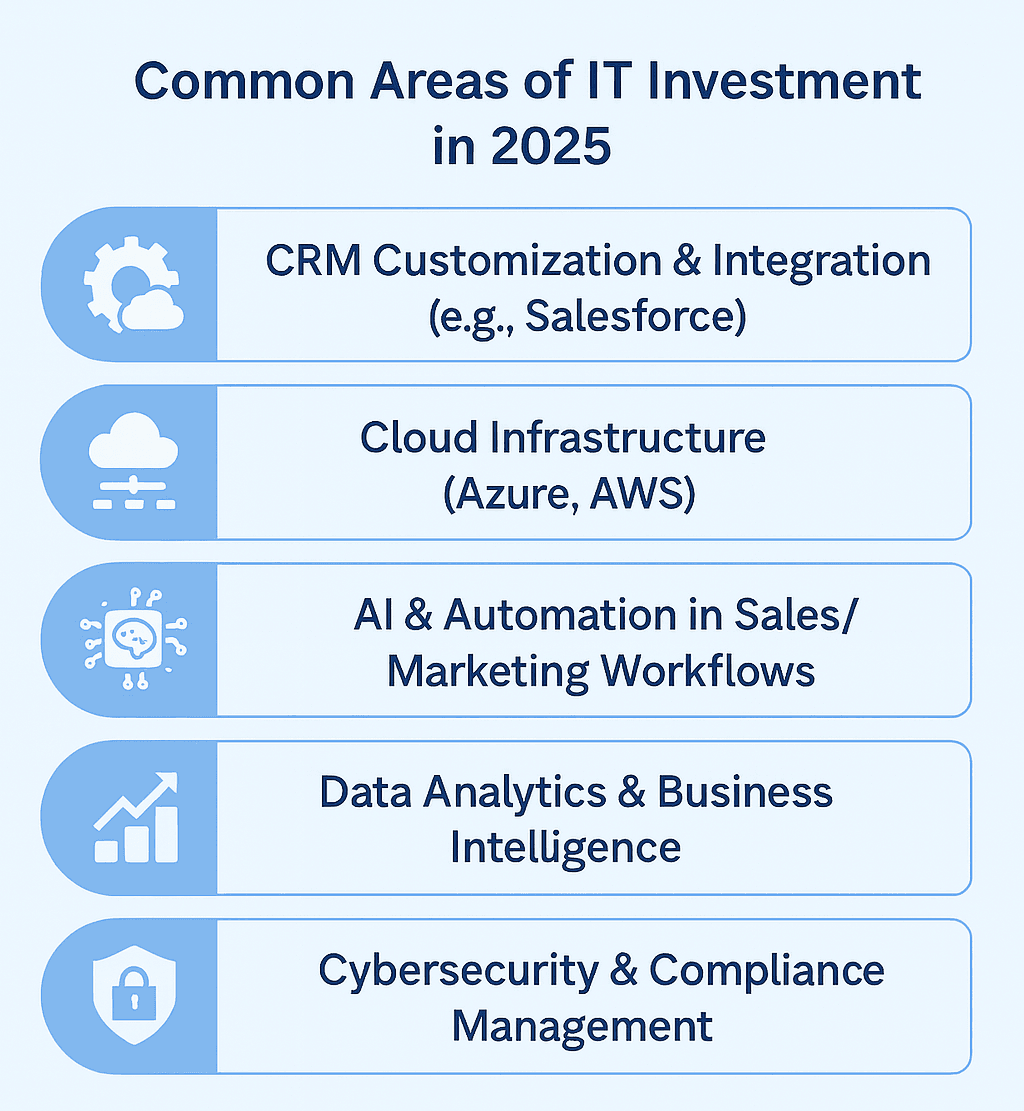
Identifying the Core Challenge: Why This Decision Matters
Many IT decision-makers find themselves at a crossroads. Internal teams already stretched thin must juggle daily support, strategic initiatives, and constant platform evolution. This creates common pain points:
- Resource Allocation: Can your team focus on driving business value, or do routine tasks hold them back?
- Expertise Gaps: Do you have access to deep knowledge of Salesforce, Dynamics, or emerging AI strategies?
- Risk & Security: Are you equipped for 24/7 incident response and compliance in the cloud?
Neglecting these considerations can lead to slow innovation, siloed data, or even operational risk. According to insights from Intellek, organizations that fail to align IT resources with business strategy risk falling behind in agility and customer experience.
The Models: In-House IT vs. Managed Services
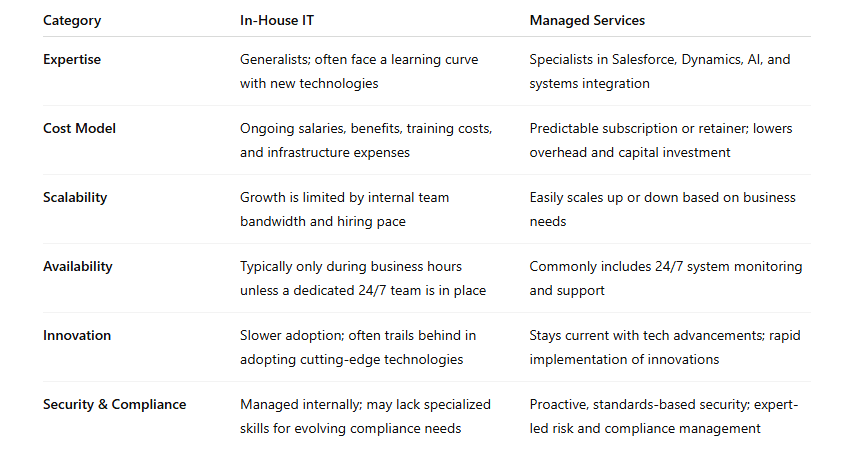
Deep Dive: The Pros and Cons of Each Approach
In-House IT: When Does It Make Sense?
- Direct control over day-to-day IT operations and change management
- Intimate knowledge of internal culture and legacy systems
- Easier collaboration for highly-custom, one-off projects
- Potential for faster decision-making (though not always execution)
However, ongoing hiring, upskilling, and retention especially in specialized domains like Salesforce integration or advanced business intelligence can be challenging and costly. Without regular exposure to new technology, in-house teams risk falling behind industry best practices. Security coverage is also often limited to business hours, increasing vulnerability.
Managed Services: The Outsourced Advantage
- Specialized Expertise: Providers like OMI offer decades of CRM, integration, and automation experience often with platform certifications and real-world implementation knowledge.
- Rapid Adoption of Innovation: Managed services stay at the forefront of emerging technologies, from AI in sales automation to real-time analytics workflows.
- Cost Predictability: Subscription pricing eliminates surprise expenses (retirement payouts, emergency hires, etc.)
- 24/7 Support & Monitoring: Essential for continuous operations, regulatory compliance, and rapid incident response.
- Focus on Core Business: Free up your internal team for strategy and differentiation, not just maintaining infrastructure.
On the other hand, the key trade-off is a perceived loss of direct control which is why transparent communication, shared goals, and clear SLAs are essential when partnering with a managed services provider.
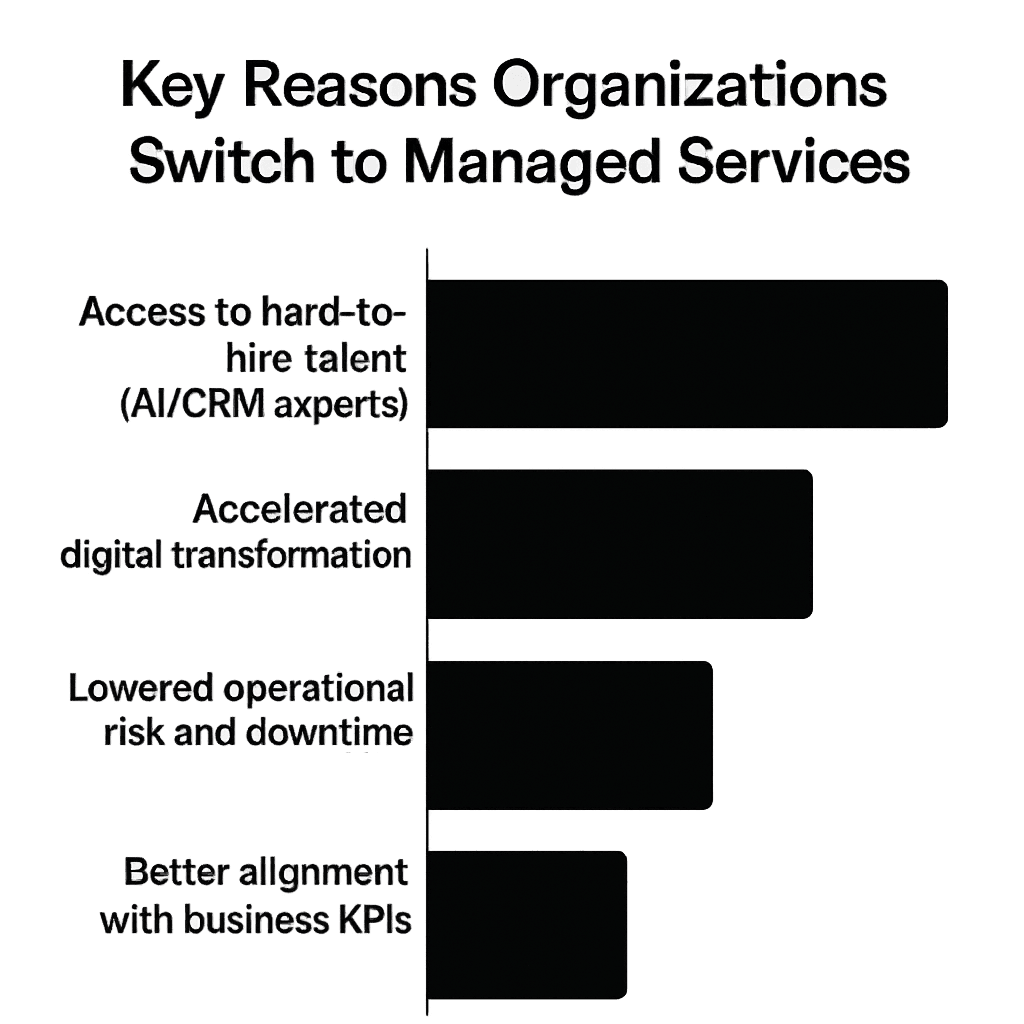
The OMI Perspective: What We’ve Learned After 25+ Years
At OMI, our clients from mid-market innovators to global enterprises often arrive with similar questions. Here’s what we’ve found works best:
A Hybrid Model Often Wins
- Retain strategic IT leadership in-house for culture, compliance, and differentiation
- Leverage managed services for platform optimization, Salesforce/Dynamics customization, advanced automation, and data-driven insights
- Build a partnership-based approach managed services should act as an extension of your team, not a replacement
Real-World Trends
- CRM Optimization: Companies accelerating Salesforce integrations and automations via managed services see time-to-value shrink dramatically.
- Data Analytics: Outsourced teams help unlock actionable insights that drive business transformation more efficiently than piecemeal internal efforts.
- AI Readiness: A managed services approach allows organizations to rapidly experiment and scale AI initiatives without overextending internal resources. See more on this trend in recent McKinsey insights.
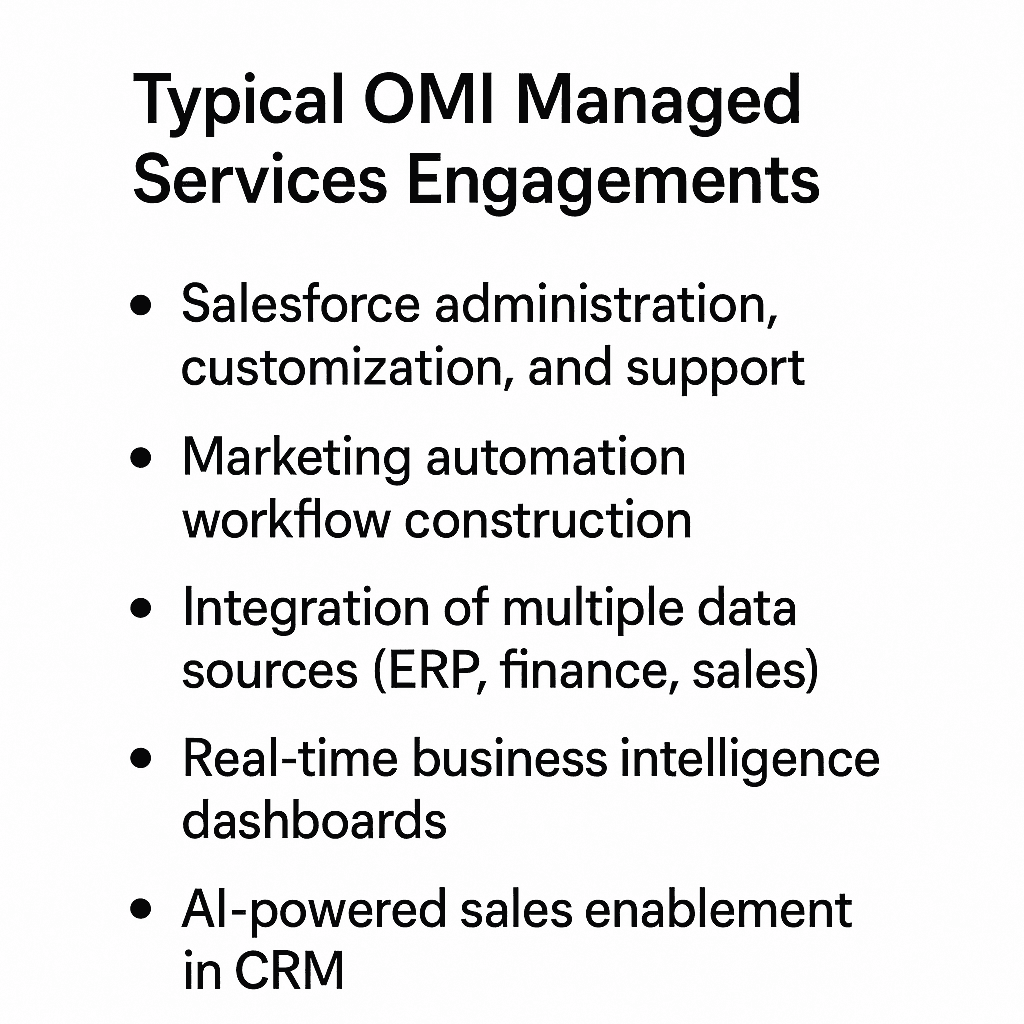
Critical Questions to Ask Before Deciding
- Do we have the in-house skills to optimize and innovate with our current CRM and marketing stack?
- Is our IT team spending most of its time on maintenance, or on projects that deliver business impact?
- Are security, compliance, and uptime fully supported, especially outside regular hours?
- Can we keep up with the pace of AI, automation, and platform evolution?
- What is our true total cost (not just salaries, but downtime, missed opportunities, training)?
Implementation Steps: Making the Transition Smooth
- Assess Core Needs: Identify which business processes are core vs. commodity. Retain control over core; outsource or automate the rest.
- Align on Outcomes: Define success metrics automation rate, time-to-market, cost per deployment, NPS, etc.
- Select a Partner, Not a Vendor: Look for managed services firms with deep platform experience and a commitment to joint success. (Contact us to learn more about OMI's approach)
- Develop a Transition Plan: Pilot with non-mission critical workflows, ramp up based on measurable results.
- Maintain Transparency: Require regular reporting, open access to knowledge, and ongoing alignment sessions between internal and external teams.
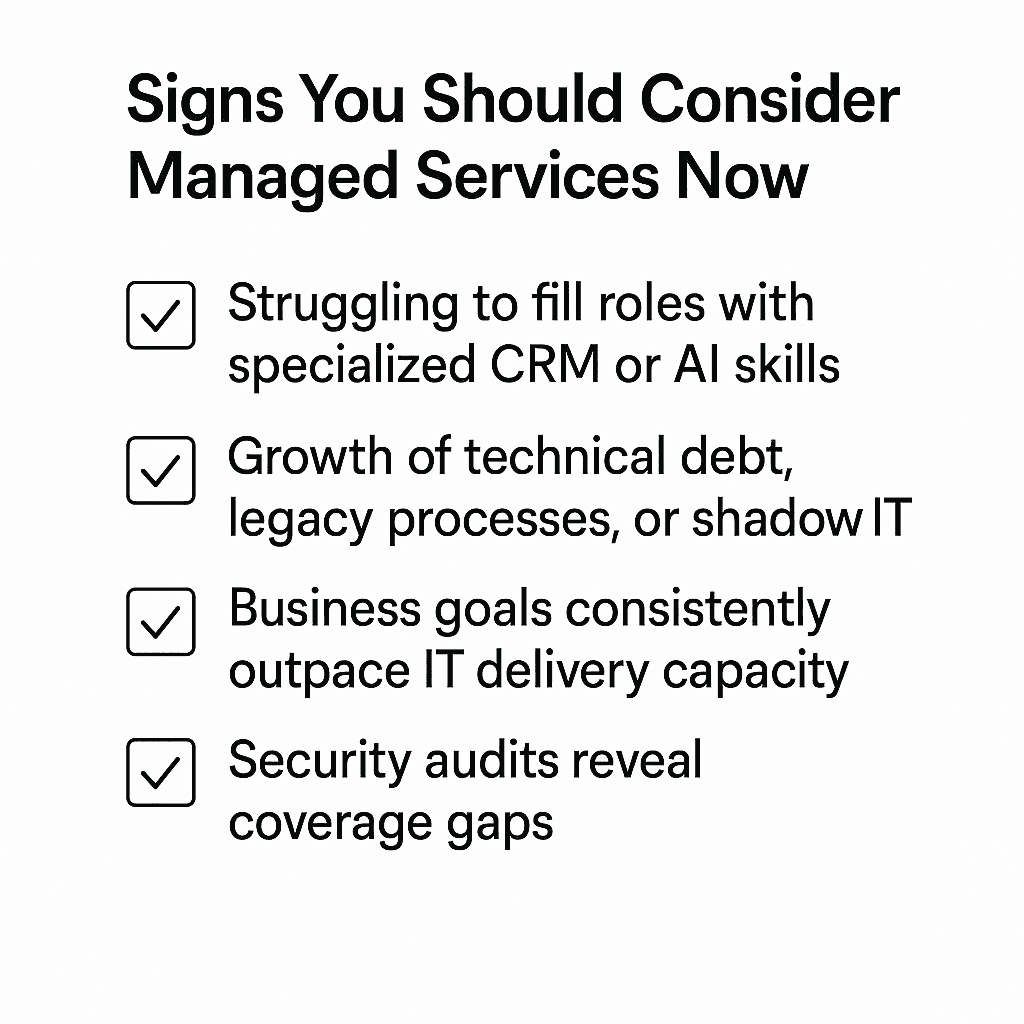
Conclusion: Embrace the Future with Confidence
Choosing between managed services and in-house IT is no longer just about cost it's about business agility, innovation, and ROI. In most cases, a blended approach maximizes strengths: keep strategic controls and culture in-house, while leveraging deep, platform-specific expertise through managed services. For Salesforce administrators, CRM consultants, and business leaders, this is the fastest route to digital transformation and ongoing competitive advantage.
Ready to explore how managed services can accelerate your business outcomes? Connect with OMI for a free consultation and discover what smart, scalable IT partnership looks like. For ongoing insights on CRM optimization, automation, and AI, visit our blog.